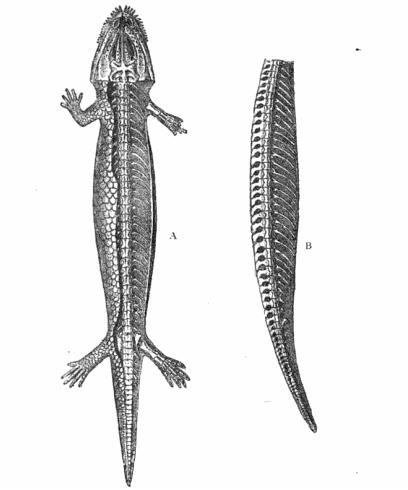Hyloplesion on:
[Wikipedia]
[Google]
[Amazon]
''Hyloplesion'' is an extinct genus of microbrachomorph
 ''Hyloplesion'' was about as large as a medium-sized salamander, with the length of known specimens ranging from 17-77mm.
The skull is triangular in shape. Unlike many other microsaurs, the palate of ''Hyloplesion'' contains large vacuities, or openings. The fifth maxillary tooth is enlarged and resembles a canine. The skull of ''Hyloplesion'' superficially resembles that of the unrelated romeriid reptile ''
''Hyloplesion'' was about as large as a medium-sized salamander, with the length of known specimens ranging from 17-77mm.
The skull is triangular in shape. Unlike many other microsaurs, the palate of ''Hyloplesion'' contains large vacuities, or openings. The fifth maxillary tooth is enlarged and resembles a canine. The skull of ''Hyloplesion'' superficially resembles that of the unrelated romeriid reptile ''
''Hyloplesion''
in the Paleobiology Database Microsauria Carboniferous amphibians of Europe Prehistoric amphibian genera Taxa named by Antonin Fritsch {{carboniferous-animal-stub
microsaur
Microsauria ("small lizards") is an extinct, possibly polyphyletic order of tetrapods from the late Carboniferous and early Permian periods. It is the most diverse and species-rich group of lepospondyls. Recently, Microsauria has been considered ...
. It is the type and only genus within the family Hyloplesiontidae. Fossils have been found from the Czech Republic near the towns of Plzeň, Nýřany, and Třemošná, and date back to the Middle Pennsylvanian
The Pennsylvanian ( , also known as Upper Carboniferous or Late Carboniferous) is, in the ICS geologic timescale, the younger of two subperiods (or upper of two subsystems) of the Carboniferous Period. It lasted from roughly . As with most oth ...
. The type species is ''H. longicostatum'', named in 1883. Two species belonging to different genera, ''Seeleya pusilla'' and ''Orthocosta microscopica'', have been synonymized with ''H. longicostatum'' and are thought to represent very immature individuals.
Description
 ''Hyloplesion'' was about as large as a medium-sized salamander, with the length of known specimens ranging from 17-77mm.
The skull is triangular in shape. Unlike many other microsaurs, the palate of ''Hyloplesion'' contains large vacuities, or openings. The fifth maxillary tooth is enlarged and resembles a canine. The skull of ''Hyloplesion'' superficially resembles that of the unrelated romeriid reptile ''
''Hyloplesion'' was about as large as a medium-sized salamander, with the length of known specimens ranging from 17-77mm.
The skull is triangular in shape. Unlike many other microsaurs, the palate of ''Hyloplesion'' contains large vacuities, or openings. The fifth maxillary tooth is enlarged and resembles a canine. The skull of ''Hyloplesion'' superficially resembles that of the unrelated romeriid reptile ''Romeria
Christianity has a strong tradition of pilgrimages, both to sites relevant to the New Testament narrative (especially in the Holy Land) and to sites associated with later saints or miracles.
History
Christian pilgrimages were first made to sit ...
'' in lateral view due to similarities in the pattern of the dermal bones and the hooked shape of the premaxilla
The premaxilla (or praemaxilla) is one of a pair of small cranial bones at the very tip of the upper jaw of many animals, usually, but not always, bearing teeth. In humans, they are fused with the maxilla. The "premaxilla" of therian mammal has ...
. However, the skull differs from that of ''Romeria'' in dorsal view, as the parietals are much wider in ''Hyloplesion''.
The atlas
An atlas is a collection of maps; it is typically a bundle of maps of Earth or of a region of Earth.
Atlases have traditionally been bound into book form, but today many atlases are in multimedia formats. In addition to presenting geographi ...
arch also resembles those of romeriids and, unlike other microsaurs, is unswollen. The trunk is elongate, with thin ribs extending from each vertebra. The presence of a large scapulocoracoid in ''Hyloplesion'' distinguishes it from ''Microbrachis''. The limb bones are small and robust, with the hindlimbs being quite larger than the forelimbs . Like other microbrachomorphs such as ''Microbrachis
''Microbrachis'' is an extinct genus of lepospondyl amphibian from the Carboniferous Kladno Formation of the Czech Republic.
Description
''Microbrachis'' was an elongated, salamander-like creature, about long, with over 40 vertebrae ins ...
'', ''Hyloplesion'' has only three digits in the manus, a condition known as tridactyly.
Paleobiology
A range of morphological characteristics makes it difficult to determine whether ''Hyloplesion'' was primarily terrestrial or aquatic. Although the digits are well ossified, the reduced number of toes in ''Hyloplesion'' is seen as an adaptation for an aquatic lifestyle. There is no evidence for lateral-line canals in the skull, although they were most likely present, separated from the skull by a layer of connective tissue.References
External links
''Hyloplesion''
in the Paleobiology Database Microsauria Carboniferous amphibians of Europe Prehistoric amphibian genera Taxa named by Antonin Fritsch {{carboniferous-animal-stub